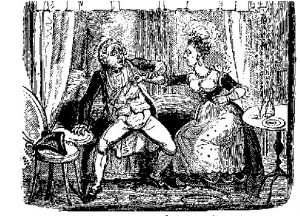A powerful terror ruled over lands in Hungary in the 16th century. For years, citizens were frightened of Elizabeth Bathory. While she lived unharmed by any authority for years, many young girls went missing or ended up dead. It took 35 years and 650 girls for the King of Hungary to take action. Even then, the punishment Bathory faced was nowhere near as cruel as what she did to these young girls.
Elizabeth Bathory, a Hungarian countess, was the daughter of Ann and George Bathory.1 She was born on August 7th, 1590, in Transylvania.2 She came from a wealthy, Protestant family that were significant landowners in Hungary. Elizabeth received a strong education, and she became fluent in several languages.3 Although she seemed to be a regular noble woman, there was a dark truth behind her family and her.

During her childhood, Bathory had a neurological disorder, and the environment around her only contributed to her sadistic ways. She suffered from epilepsy as a child, possibly from familial inbreeding. To cure her epilepsy, her family took blood from servants and put it on her lips. This is thought to be one of the reasons she became obsessed over blood. During this time, no laws protected servants or peasants from being tortured. Her family contributed to her sadism by torturing their servants and peasants.4 One story suggests that after Bathory witnessed a man being sewn into a horse’s stomach for theft, she laughed at the sight of it.5 Bathory saw her family members torture their servants for fun, and this turned her adolescent self into a full-blown killer.
Her life shifted when she married Ferenc Nadasdy, a noble from Hungary. Nadasdy moved Bathory to his estate in Savar. At times, Bathory’s husband went away at war, but when he was at home, he shaped Bathory in how she killed.6 Nadasdy enjoyed torturing peasants and servants in brutal ways. There is a rumor that Elizabeth became pregnant by a peasant right before she married Nadasdy, and he castrated the peasant and gave his body to wild dogs to eat. Bathory’s husband enjoyed killing so much, especially during wars, that he received the nickname “Black Knight of Hungary.”7 Nadasdy taught Bathory new techniques or tricks when torturing her servants. For example, he instructed her to strip her servants naked, cover them in honey, and let bugs eat at them.8 Elizabeth’s husband, Nadasdy, was yet another influence to why she became obsessed with torturing her servants. While Nadasdy taught her how to torture, yet another person in her life would teach her how to kill.
While Elizabeth’s husband was away at war, she met a witch named Anna Darvulia. This witch inspired most of Bathory’s brutal and sadistic killings. Darvulia supposedly implanted in Bathory’s mind that if she killed young virgins and bathed in their blood, she could maintain her youth.9 Bathory confided in Darvulia and took interest in learning more about witchcraft and Satanism. When Darvulia died a few years later, Bathory had to find another women to confide in while doing her killings. She met Erzsi Majorova soon after, who practiced witchcraft. Majorova convinced Bathory to kill noble women because fewer and fewer servants wanted to work for Bathory. Bathory took the advice, which turned out be a mistake for her. People grew more suspicious after she killed one noble girl. She tried to cover it up by saying the girl committed suicide. This is the turning point where Bathory began killing sporadically, and it eventually led to her arrest.10
When Nadasdy passed away in 1604, he gave his whole estate away to Bathory including his castle, Cachtice, in modern day Slovakia. In the years after Bathory’s husband passed, whispers floated around about Bathory’s actions, specifically her killing young girls. Istvan Magyari, a Lutheran minister, filed a complaint about Bathory. The King of Hungary, King Matthias II, ordered Gyorgy Thurzo, Palatine of Hungary, to look into the rumors and accusations about Bathory. Thurzo investigated and accumulated hundreds of witnesses, and a few were willing to testify against Bathory. During the trial, witnesses explained how Bathory would lure in servant girls to kill. She did this by saying she would give them a higher salary.11 The testimonies included how she killed the girls by mutilating their bodies, starving them, freezing them, and torturing them. Inside her castles, there were torture chambers. She used tools such as knives, razors, and wax to torture them.12 She would also bite pieces of flesh off of her victims.13 The people who lived in the same town as Bathory saw the girls that she tortured while they ran errands. Their hands showed burn marks, or their faces were disfigured. One girl even came running out of the castle with a knife still in her foot.14 The king showed no compassion or care for the peasants or servants being killed. It was only when noble girls started disappearing and dying that he demanded Thurzo to look into it.

One day, Thurzo showed up to Bathory’s castle with armed guards. Thurzo found a dead body of a girl and two other girls wounded. Thurzo heard screaming, which led him to find one of Bathory’s torture chambers. It is not known if Elizabeth was actually caught in the act of harming her servants. Elizabeth pleaded her innocence to Thurzo, though he did not believe her, and he eventually arrested her.15 Bathory was only put on house arrest, because they did not want to cause a scene to the public, but rumors were already going around about what she did. She eventually was put on trial.
Soon after her arrest, Bathory attended the trial against her. She pled innocent to each crime. Bathory’s servants, thirteen in total, testified against her. One of the servants provided a list in Bathory’s handwriting of all 650 of her victims. The servants and Majorova who helped gather young women for Bathory to kill were all killed by either burning or beheading as a result of the trial.16 Elizabeth did not face a harsh death sentence. Instead, she was diagnosed as criminally insane.17
After the trials concluded, Thurzo founded Bathory guilty, and she stayed in solitary confinement in her castle, Cachtice, for the rest of her life. The citizens of Hungary did not even speak Bathory’s name for hundreds of years.18 Conspiracy theories argue that Bathory was actually innocent. These theories suggest that the King brought these charges against her because he did not like that she was Protestant and a powerful women.19 However, no evidence exists to back up these theories.

A few years later, Elizabeth Bathory died in solitary confinement on August 22, 1614. She told her guard that her hands were cold, and the next day the guard found her dead.20 She was buried somewhere around her castle, Cachtice. Any remains or signs of her or her body cannot be found today. During the time she lived, she was one of the most powerful women in Hungary.21 She gained notoriety and received the nickname “Blood Countess” through her deviant acts.22 Bathory is known today for being one of the worst female, serial killers. There are only secondary accounts of her actions. There is still no physical evidence to this day that proves she is innocent or guilty.
- Encyclopedia of Murder and Violent Crime, 2003, s.v. “Countess Elizabeth Bathory,” by Lisa Andrews. ↵
- Salem Press Biographical Encyclopedia, 2018, s.v. “Elizabeth Báthory,” by Gavin R.G. Hambly. ↵
- Douglas Brode and Leah Deyneka, Dracula’s Daughters the Female Vampire on Film (Lanham: The Scarecrow Press, Inc., 2014), 139. ↵
- Wikipedia, 2019, s.v. “Elizabeth Báthory.” https://en.wikipedia.org/wiki/Elizabeth_Báthory. ↵
- Tori Telfer, Lady Killers Deadly Women Throughout History (New York: Harper Perennial, 2017), 2. ↵
- Salem Press Biographical Encyclopedia, 2018, s.v. “Elizabeth Báthory,” by Gavin R.G. Hambly. ↵
- Tori Telfer, Lady Killers Deadly Women Throughout History (New York: Harper Perennial, 2017), 4. ↵
- The Vampire Book: The Encyclopedia of the Undead, 2010, s.v. “Bathory, Elizabeth (1560-1614),” by J. Gordon Melton. ↵
- Salem Press Biographical Encyclopedia, 2018, s.v. “Elizabeth Báthory,” by Gavin R.G. Hambly. ↵
- The Vampire Book: The Encyclopedia of the Undead, 2010, s.v. “Bathory, Elizabeth (1560-1614),” by J. Gordon Melton. ↵
- Wikipedia, 2019, s.v. “Elizabeth Bathory.” https://en.wikipedia.org/wiki/Elizabeth Bathory. ↵
- Encyclopedia of Murder and Violent Crime, 2003, s.v. “Countess Elizabeth Bathory,” by Lisa Andrews. ↵
- The Vampire Book: The Encyclopedia of the Undead, 2010, s.v. “Bathory, Elizabeth (1560-1614),” by J. Gordon Melton. ↵
- Tori Telfer, Lady Killers Deadly Throughout History (New York: Harper Perennial, 2017), 12. ↵
- Tori Telfer, Lady Killers Deadly Women Throughout History (New York: Harper Perennial, 2017), 14. ↵
- Salem Press Biographical Encyclopedia, 2018, s.v. “Elizabeth Báthory,” by Gavin R.G. Hambly. ↵
- Encyclopedia of Murder and Violent Crime, 2003, s.v. “Countess Elizabeth Bathory,” by Lisa Andrews. ↵
- Douglas Brode and Leah Deyneka, Dracula’s Daughters the Female Vampire on Film (Lanham: The Scarecrow Press, Inc., 2014), 140. ↵
- The Vampire Book: The Encyclopedia of the Undead, 2010, s.v. “Bathory, Elizabeth (1560-1614),” by J. Gordon Melton. ↵
- Wikipedia, 2019, s.v. “Elizabeth Báthory.” https://en.wikipedia.org/wiki/Elizabeth_Báthory. ↵
- Douglas Brode and Leah Deyneka, Dracula’s Daughters the Female Vampire on Film (Lanham: The Scarecrow Press, Inc., 2014), 139. ↵
- Encyclopedia of Murder and Violent Crime, 2003, s.v. “Countess Elizabeth Bathory,” by Lisa Andrews. ↵



65 comments
Elizabeth Santos
It’s rare to read about female serial killers, but they are surely always so intriguing and complex. It’s insane how Elizabeth Bathory’s family fed her illness and nurtured her way of killing. Also what a pairing! She got a husband just as sadistic and horrible. I also want to know more about the witches she found to confide in. When the second witch had told her to try killing noble girls, I wonder what her intentions were. I mean yes, it was an alternative, but I wonder if the witch wanted her to get caught as the death of a noble would reasonably bring much attention. I also found it interesting how before she died, Bathory stated that her hands were cold, it’s almost as if she knew her end was soon.
Adrianna Hernandez
Amazing article! I had no clue that this woman existed. When I read the title I thought that it was going to be about someone just middle classed, but no it was about a woman that was rich and powerful. I was really into the article especially when I read that she would torture them at her castle. I wonder what made her go after noble girls when she would only torture servants and peasants.
Reagan Clark
This article is amazing! I had no idea this woman even existed. This article was fascinating! The title suits the crime: “Blood Countess.” I cannot believe that all of those people enabled her to murder at least 650 people for fun. Even the King did not do anything. It is barbaric, but fascinating. I wonder what made her decide to go after noble girls later. Did she choose specific noble girls? Was it random? Did she ever get hired to murder some of these people? The possibilities are endless! Good job!
Emilia Caballero Carmona
Hey Hannah! I loved your article because I have always had an interest for serial killer stories. However this story is different because Elizabeth Bathory was a noble and she was rich and powerful. The part that surprised me the most was that a witness testified Elizabeth killed over 650 people throughout her life, which is really scary because she never saw an end to her obsession with death.
Julianna Olivarez
Elizabeth Bathory from a young age was a disturbed girl from a disturbed family that would find pleasure in torturing servants and peasants. It comes to show how much your own family can impact you mentally and physically, and when she grew up she married a man that had the same sadistic tendencies as her. Then her meeting the witch that told her that soaking in the blood of young girls is what escalated her serial killer tendencies. But what baffles me is that she went unnoticed for 35 years, it wasn’t until she started killing noble girls that they took notice and investigated the disappearances.
Aracely Beltran
While disturbing, I could not stop reading. I was really grossed out when they mentioned the servant being sewn into a horse’s stomach. As I continued reading, I kept thinking “why have I heard of someone else who did this?” and then it clicked! They made Elizabeth Bathory in the show “American Horror Story”. She rubs their blood everywhere it is gross.
Savannah Alcazar
The title “Elizabeth Bathory: The Countess Who Bathed in Blood” caught my attention immediately from the crime page. Her body count of 650 young girls in 35 years is mind blowing. The old ways of medicine seem to have really affected the way she lived throughout adulthood. Her parents messed her up mentally; one thing I’ve realized in adulthood is that parents can REALLY mess their kids up. It’s insane she married someone that fit her murderous life…
Melanie Fraire
It’s insane how many victims she had and the countless ways she had to killing them, each being even worse than the previous. The crazy thing to me about this article was how her serial killer ways in her adulthood were all influenced by her childhood and everything she was exposed to and it made me wonder if she would’ve been normal had she not experienced that.
Margaret Cavazos
This article was chilling to read and although it is very detailed, it ends without being able to prove whether or not the countess actually was the serial killer described. If the story is true, then it is disturbing how many were killed and the ways in which they were killed. It’s also appalling that the king refused to intervene until nobles were being murdered. Although the countess may have indeed had epilepsy, how her family chose to treat her was unacceptable, and it is tragic that there were not more protections for the servants and peasants.
Ana Cravioto Herrero
What an interesting story! I wish there was clear evidence so that there could be closure to this story, but I guess the mystery adds to this incising story. It is very disgusting and weird what she did, especially because most serial killers tend to be males. It is also very strange that remaining of her body have yet to be found, and I wonder if there will ever be more information that comes out about her life or the victims.